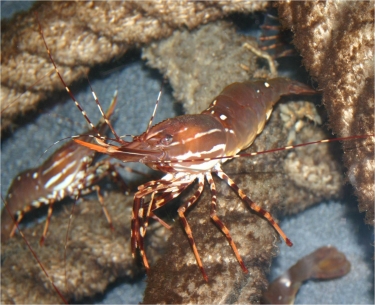Alaska Species Explorer
All
x
- – No known individuals remaining.
- – Known only to survive in captivity, or as a naturalized population outside its historic range.
- – Extremely high risk of extinction in the wild.
- – High risk of extinction in the wild.
- – High risk of endangerment in the wild.
- – Likely to become endangered in the near future.
- – Lowest risk. Does not qualify for a higher risk category. Widespread and abundant taxa are included in this category.
- – Not enough data to make an assessment of its risk of extinction.
- – Has not yet been evaluated against the criteria.
Spot Prawn
- – No known individuals remaining.
- – Known only to survive in captivity, or as a naturalized population outside its historic range.
- – Extremely high risk of extinction in the wild.
- – High risk of extinction in the wild.
- – High risk of endangerment in the wild.
- – Likely to become endangered in the near future.
- – Lowest risk. Does not qualify for a higher risk category. Widespread and abundant taxa are included in this category.
- – Not enough data to make an assessment of its risk of extinction.
- – Has not yet been evaluated against the criteria.
North Pacific Ocean from Sea of Japan to Alaska’s Aleutian Islands through SE Alaska to S. California
In coldwater reefs and rocky habitats to 460m (1510ft) deep to near the surface; more common 90m (300ft).
Eggs are carried on females’ abdomen during winter and hatch at depths greater than 150m (490ft) in late winter. The larval shrimp, called nauplii, feed on zooplankton in the water column until they settle to the bottom. They molt repeatedly throughout their life, growing larger with each molt.
Other shrimp, worms, sponges, small mollusks, carrion, plankton. Spot shrimp and their relatives tend to forage at night and seek cover during the day.
Spot shrimp populations are considered stable in SE Alaska but they have been reduced in numbers in other Alaskan waters. Commercial and sport harvests are now closely managed to conserve numbers.
Pink shrimp, Pandalus eous, and sidestripe shrimp, Pandalopsis dispar, are in the same family as spot shrimp and are two other commercially valuable species.
- Spot shrimp are the largest shrimp in the North Pacific Ocean.
- A spot shrimp begin life as a male and changes sex to become a female toward the end of its life. It spawns once as a male and one or more times as a female.
- Female spot shrimp, being older, are also much larger than the younger males.








